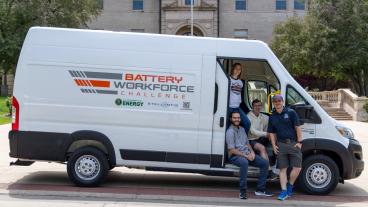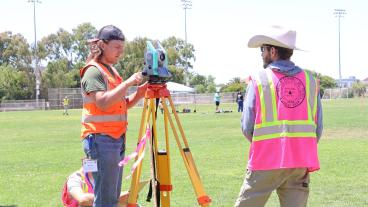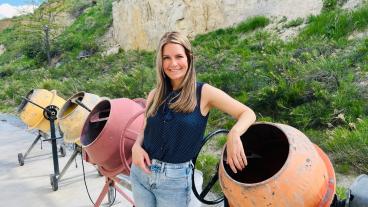Imagine a 10,000-square-foot “food hub” that would allow Golden residents access to local foods from Front Range farmers. Eileen Regan, an active member of Golden Farming Cooperative (GoFarm), asked Mines senior design students in the College of Engineering and Computational Science to outline how the nonprofit could construct a green, low-impact, mobile CSA pick up site where farmers could store and distribute their products.
“Right now, local food (especially organically grown local food) is not very affordable and there’s a need for accessibility,” said Regan. “Golden has historically served as a depot, and intersects the six major agricultural regions. I’m hopeful that that this would allow us to connect with a local food network across the state.”
The project originally started with one Mines senior design team and soon morphed into three teams as one needed to focus on the facility’s design, another on a refrigeration model and one on eliminating food waste.
The team “Turnip the Beet,” made up of six students (three civil engineering and three environmental engineering), analyzed the cost, floor plan and materials for the warehouse. After researching sustainable design options, they chose an Eco-Smart roof with recycled materials, a glass curtain wall, structural insulated panels (SIPs) and an aluminum sun shade.
“We wanted our building to be as passive as possible so that we could help GoFarm lower their energy costs,” said environmental engineering student Taylor Baird. “Our sun shade allows the most sunlight into the building through the glass curtain wall during the winter and the least amount during the summer. SIPs provide the warehouse with vertical support as well as insulation that helps maintain a constant temperature within the four temperature zones.”
In order to know what types of materials to use, Baird’s team used data from the Golden Energy Solutions team, who were looking at “green” ways to refrigerate the food hub. Along with five other mechanical engineering students, Carly Conley worked with her team to build a refrigeration model using EnergyPlus, an energy simulation software.
“We chose a geothermal/vapor-compression hybrid system because it was the most efficient and environmentally responsible option,” said Conley. “Using this system, we could generate around 30 percent energy savings, which translates to the food hub requiring a 9-ton cooling system.”
Another team, Dynamic Energy Providers (three mechanical engineering students and two electrical engineering students), analyzed how different power sources could work together to remove food waste and turn it into energy. Their design utilizes two different natural gas generators—one that powers the refrigeration model and one the storage and dry food load.
“We started researching all passive options (wind, solar, natural gas) and narrowed it down to using natural gas generators so that it could be as off-the-grid as possible, and we chose a biodigestor to break down food waste into biogas,” said mechanical engineering student Reed Sanchez. “We’re creating free energy and doing something about the food waste. The biodigestor helps lower the cost of operation, which in turn lowers the cost to consumers and farmers.”
GoFarm’s food hub is slated for construction in or near Golden in 2018.
Contact:
Kathleen Morton, Communications Coordinator / 303-273-3088 / KMorton@mines.edu
Karen Gilbert, Director of Public Relations / 303-273-3541 / KGilbert@mines.edu



